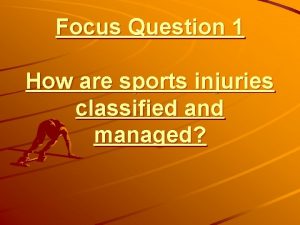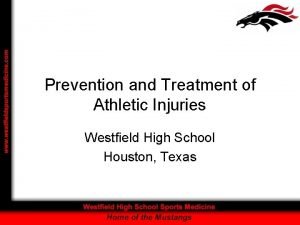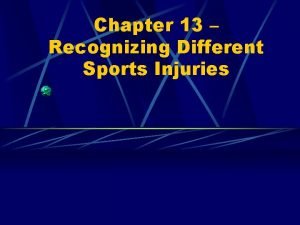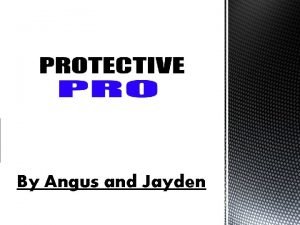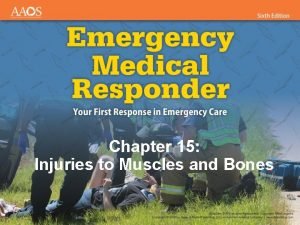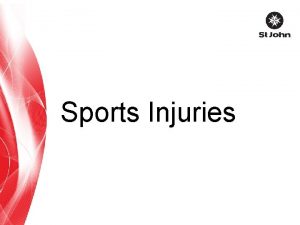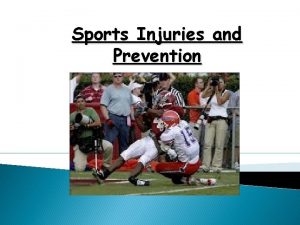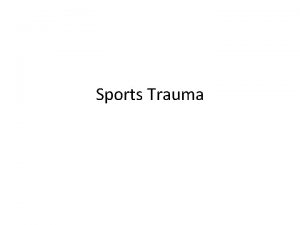How are sports injuries classified and managed Focus














- Slides: 14

How are sports injuries classified and managed? Focus Question 1

What we’re covering today…

• Hard tissue injuries • Definition: Any injury relating to bones and teeth (the skeletal system) • Two types: • Fracture • Dislocation

- Fracture • Definition: A broken bone • Three classifications: • Closed: break remains inside the body • Open: a break that pierces the skin and the bone can be seen • Complicated: a break where the bone causes further damage, to nerves, organs and blood vessels • Three types: • Complete: breaks clean through the bone (2 parts) • Incomplete (Greenstick): does not break the whole way through the bone • Comminuted: more than two parts to the bone (smashing of bone or multiple fractures in the one bone

- Fractured (Continued) • Signs and symptoms: • • Hearing or feeling a break Hearing or feeling a grating of bone Pain Redness Loss of function Deformity Bone protruding from skin (open fracture).

• Management of Hard Tissue Injuries (Fracture) • Aims: • Reduce pain • Prevent further bleeding • Reduce bleeding and shock • A first aider should: • • DRSABCD Control bleeding Cover wounds Check for other injuries (e. g. shock) Keep the casualty still and remain calm Handle gently Immobilise fracture (dash point) Seek medial attention (dash point)

- Dislocation • Definition: The displacement of a bone at a joint. An abnormal separation in a joint between two bones • Caused by excessive force and can be either direct or indirect • Frequent dislocations occur in the fingers and ball and socket joints (shoulder and hip) • Sublaxation: A bone might momentarily ”pop out” and quickly return to place (“pop in”)

- Dislocation (Continued) • Signs and symptoms: • • • Pain at the joint Swelling around the joint Bruising around the joint or just below the joint Deformity of the joint Tenderness around the joint Inability to move the joint properly • Often these injuries are readily identifiable as the athlete often will clutch at the joint and allow the rest of the limb to hang, or support their limb quickly to immobilise it.

• Management of Hard Tissue Injuries (Dislocation) • First DRSABCD • Then • DO: • Check for circulation past the joint • Support the area and IMMOBILISE (dash point) through the use of slings • Apply ice packs • DO NOT: • Move the joint • Put the joint back in place

• Assessment of injuries – TOTAPS • TOTAPS is an acronym that stands for: • • • Talk Observe Touch Active movement Passive movement Skills test. • It is used to assess the nature and extent of injury to a player and determine whether or not the injured person can return to the field. If the player can complete all tasks required, they should be allowed to return to play. • However, if the player is unable to complete any one of the requirements, the assessment is stopped and First Aid should be administered and medical attention is sought

- TOTAPS • Talk to the player to find out exactly what happened. This provides valuable information about the nature of the injury. Ask questions such as: • Where does it hurt? How painful is it out of 10? Is the pain sharp or dull? Did you hear a snap or a crack? How did it happen? • Observe • Look at the injury and see if there any obvious signs of swelling or deformity. • The easiest way to assess if an area is swollen is to compare both sides of the body. • Touch • Gently feel the injury for any sign of deformity or swelling and try to pinpoint the area of pain. • Active movement • Ask the player to perform a range of joint movements such as flexion, extension and rotation. • Passive movement • The assessor physically mobilises the joint (flexion, extension, rotation) using a range of movements aimed at identifying painful areas and any instability in the joint. • Skills test • In this phase the player is asked to perform a skill that is required during the game — for example, a sidestep. • If the player is able to perform to the satisfaction of the assessor, then the player can return to the game.

• Perform assessment procedures to determine the nature and extent of injury in simulated scenarios. • Each person has been given a different scenario • Apply the TOTAPS procedure to determine the nature and extent of the injury • REMEMBER: Medical help is to be sought when a serious injury is suspected!! • You are to complete the table based on your scenario and report back to the class where you are the EXPERT FIRST AIDER and will inform everyone else of what you would do in that situation • Make sure you write down each experts advice in your own table

Exam Style Questions: 1. Outline types of soft tissue injuries (3 marks) 2. Describe the assessment procedure used to determine the nature and extent of a sports injury (5 marks)

Revision Quiz: • https: //play. kahoot. it/#/k/2 ed 7438 a-bd 1 d-48 d 7 -ab 0 b 395 c 5 b 8 a 4 b 45
 How are sports injuries classified and managed
How are sports injuries classified and managed Antigentest åre
Antigentest åre Chapter 11 assessment and evaluation of sports injuries
Chapter 11 assessment and evaluation of sports injuries Westfield sports injuries
Westfield sports injuries Chapter 13 worksheet recognizing different sports injuries
Chapter 13 worksheet recognizing different sports injuries Sports injuries angus, on
Sports injuries angus, on Porter's competitive strategies
Porter's competitive strategies Cost focus and differentiation focus
Cost focus and differentiation focus Prolepsis
Prolepsis Actor focus vs object focus
Actor focus vs object focus Indoor sports and outdoor sports
Indoor sports and outdoor sports Unit 15:7 providing first aid for heat exposure
Unit 15:7 providing first aid for heat exposure Chapter 28 head and spine injuries
Chapter 28 head and spine injuries Chapter 21 caring for head and spine injuries
Chapter 21 caring for head and spine injuries Emr chapter 15 injuries to muscles and bones
Emr chapter 15 injuries to muscles and bones
